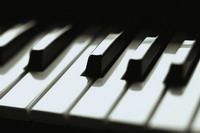Piano Sheets > Lionel Hampton Sheet Music > Flying Home (ver. 2) Piano Sheet
Flying Home (ver. 2) by Lionel Hampton - Piano Sheets and Free Sheet Music

About the Song
Other avaliable versions of this music sheet: Version 1 Version 2
"Flying Home" is a 32 bar AABA jazz composition most often associated with Lionel Hampton, written by Benny Goodman, Eddie DeLange, and Lionel Hampton. The song was reportedly developed around a tune Hampton whistled as he nervously waited for his first flight on an aircraft[1]. It was first recorded by the Benny Goodman Sextet in 1939 featuring solos by Hampton and Charlie Christian.
Several other groups subsequently recorded the tune, however the most famous version is a lively 1942 recording by Lionel Hampton and His Orchestra, featuring a tenor sax solo by Illinois Jacquet
In 1942, at age 18, Jacquet soloed on the Hampton Orchestra's version, one of the very first times a honking tenor sax was heard on record. The record became a hit. It was a jazz classic, as well as what can be considered one of the first rock and roll records. The song immediately became the climax for the live shows and.
Download this sheet!
About the Artist

Random article
How to read sheet music How to read sheet music
Reading piano sheet music is no simple thing. For it first we require to know the individual elements of the composition itself in order to read sheet music. You must make sure that you are familiar with that particular composition's language before you tackle the entire piece.
In order to grasp the intent and nuances of the piece quickly for reading piano sheet music following steps are to be considered:-
1> To start with have a look over entire composition to get the feel of the length and style of the sheet music. This first run through is just to have a quick overview of the composer's work. This will slowly prepare you to read the sheet music.
(More...)
